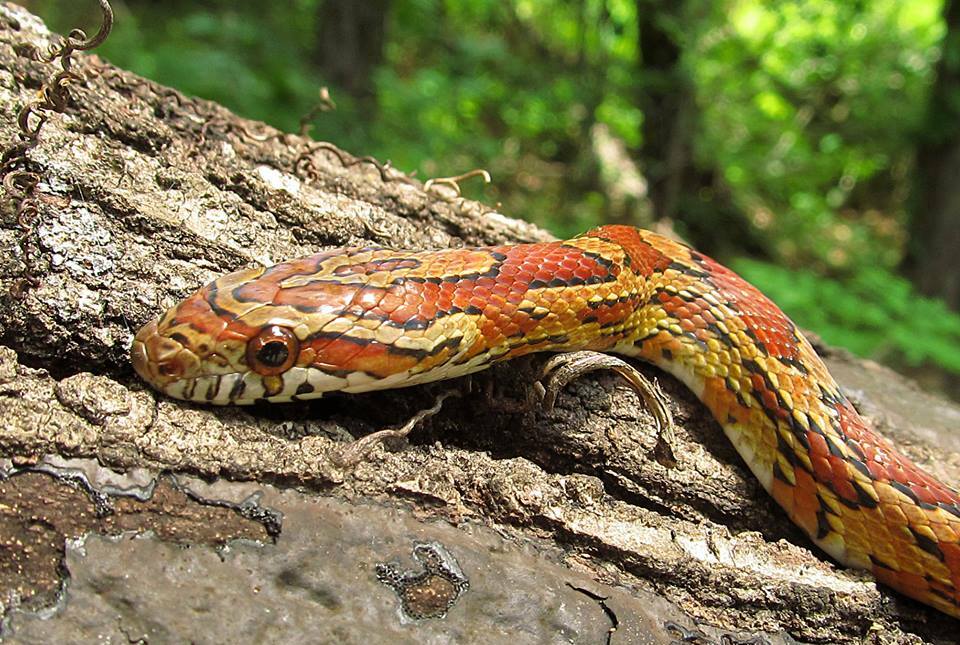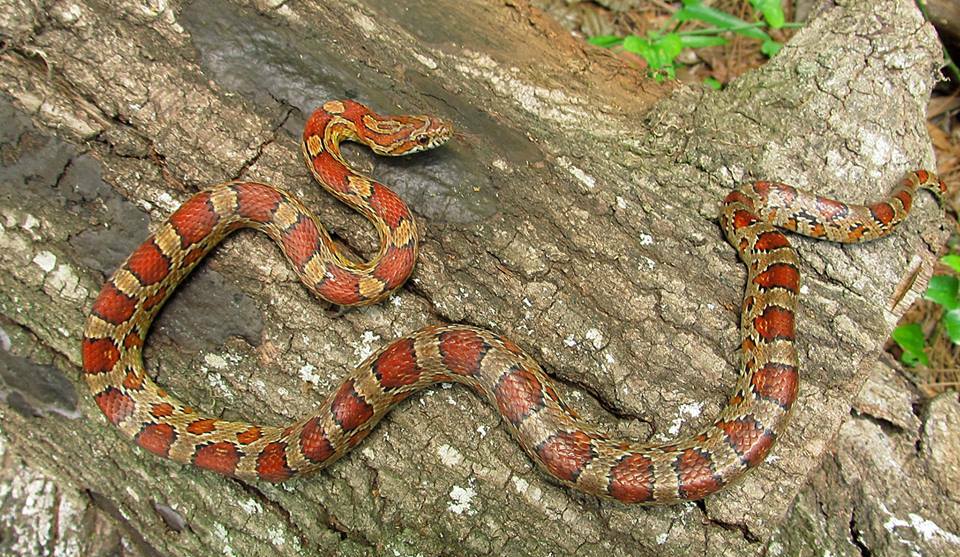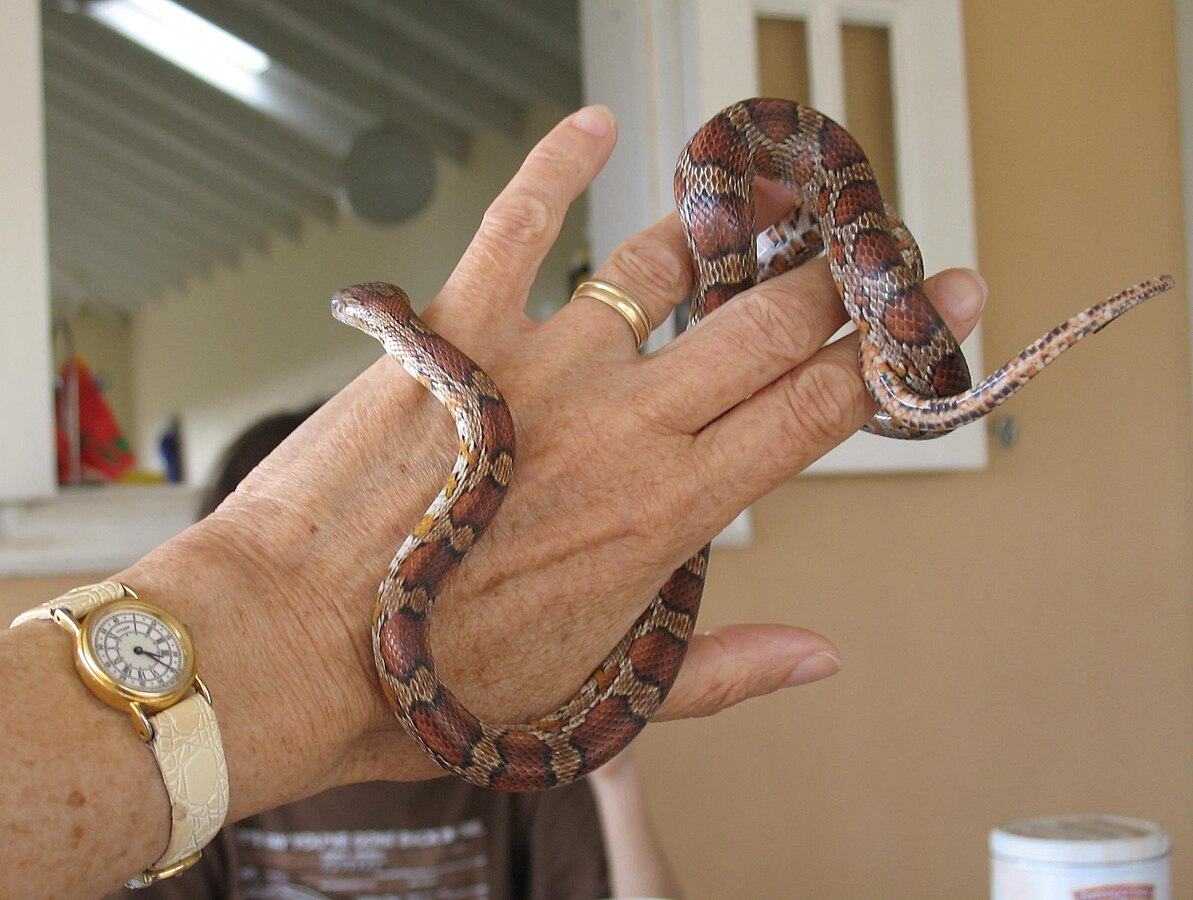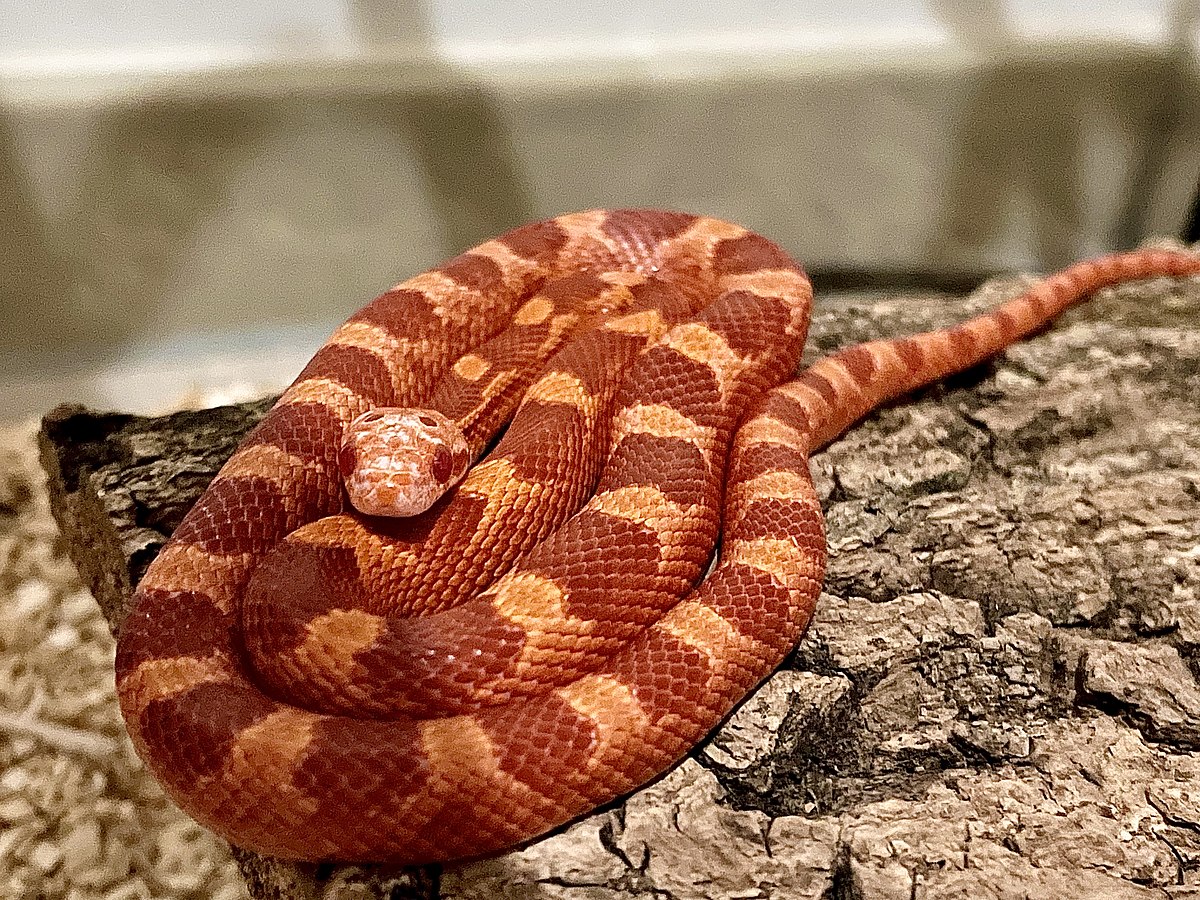Scale rot in corn snakes is an alarming condition marked by discolored, wrinkled scales, and inflammation. It’s caused mainly by too much dampness in your snake’s room, which leads to nasty infections. But don’t worry, good hygiene, monitoring humidity levels, and installing smooth surfaces in the enclosure can deter this condition. Sometimes, even with all these measures, your snake might still get scale rot due to unexpected injuries. Regularly checking on your snake’s health helps spot trouble early. Let’s take a closer look at scale rot signs.
If you suspect your corn snake has scale rot, it’s crucial to seek veterinary care promptly. Proper diagnosis and treatment may involve topical medications, antibiotics, and environmental adjustments to ensure your snake’s health and well-being.
Identifying Corn Snake Scale Rot Symptoms

Scale rot is a distressing condition for your pet corn snake, but catching it early can help make the treatment process much more manageable. So, let’s delve into the signs and symptoms to look out for.
When it comes to scale rot, there are a few key manifestations to be aware of. Firstly, discolored scales are often a telltale sign. This can present as a darkening or reddening of the scales, and they may appear wrinkled or rough to the touch. It’s important to note that these changes may not be uniform and can appear in patches.
Color and Texture Changes Associated with Scale Rot
Condition |
Description |
|---|---|
Discoloration |
Scales appearing darker or redder than normal |
Texture |
Scales feeling rough or appearing wrinkled |
In addition to abnormal changes in color and texture, affected areas may also exhibit redness and inflammation. The skin around the scales might appear swollen or irritated, signaling that something isn’t right with your snake.
Furthermore, an excessive secretion of fluid or pus from the affected area is another red flag. If you notice any discharge from the skin, particularly near the affected scales, it’s crucial to take action immediately and consult a reptile experienced veterinarian.
Imagine if you had a cut on your hand that was swollen, red, and oozing fluid – it would clearly indicate that something was wrong. Similarly, these symptoms in your snake indicate that their skin is not as healthy as it should be.
The physical signs are vital to notice, but changes in behavior can also offer important clues about your snake’s health. Let’s delve into those next.
Understanding The Causes of Corn Snake Scale Rot

Scale rot, a common ailment among corn snakes, can be attributed to several factors. One of the principal contributors to scale rot is excessive moisture within the snake’s habitat. Moist environments create an ideal breeding ground for bacteria and fungi, leading to skin infections in your pet snake. This underscores the significance of maintaining optimal humidity levels within the enclosure to prevent scale rot.
Apart from excessive moisture, poor hygiene practices that result in unclean enclosure surfaces can also contribute to the development of scale rot. Accumulation of waste or leftover food particles can introduce harmful bacteria and fungi, increasing the risk of skin infections. Regular cleaning and disinfection of the enclosure are essential to mitigate these risks.
Furthermore, rough or sharp enclosure surfaces pose a threat to the delicate skin of corn snakes. Abrasive substrates, decorations, or damaged enclosure structures can cause physical injury to the snake, providing entry points for pathogens that could lead to scale rot. It’s important to regularly inspect and smooth out any rough surfaces in the enclosure.
Injuries such as cuts or scrapes can compromise the snake’s skin integrity, making it more susceptible to infections. Ensuring a safe and secure environment for your corn snake is crucial in preventing injuries that could lead to scale rot.
It’s similar to how we need to ensure a clean and safe environment for ourselves to prevent infections and injuries. Just like how we manage our own hygiene and safety, it’s important to take proactive measures in maintaining a suitable habitat for our animal companions.
Understanding these causes will help us take informed steps towards preventing scale rot in our corn snakes. By addressing these factors proactively, we can ensure that our pets remain healthy and thriving in their habitats.
Armed with an understanding of the causes, let’s explore preventive measures specifically tailored to thwart scale rot in corn snakes.
See Related: Okeetee Corn Snake: A Comprehensive Guide to Breeding, Care, and Colors
Prevention Tactics for Corn Snake Scale Rot

Preventing scale rot in corn snakes involves a combination of careful husbandry practices, attentive care, and proactive health assessments. Let’s explore some key strategies to protect your corn snake from this skin disorder.
Proper Enclosure Conditions
Ensuring the optimal balance of humidity and temperature within the snake’s enclosure is crucial. Corn snakes thrive in environments with a relative humidity of approximately 40-60%, depending on the specific species. It’s essential to provide a suitable thermal gradient as well, with a warm basking area and cooler zones. This allows them to regulate their body temperature according to their needs. Employing appropriate bedding materials such as aspen shavings or cypress mulch helps maintain cleanliness and prevent excessive moisture buildup, which can contribute to the onset of scale rot. Regular cleaning and sanitation of the enclosure are imperative to eliminate harmful bacteria or fungi that could potentially harm your snake’s scales.
Using a digital hygrometer and thermostat is an effective way to monitor and maintain ideal environmental conditions in the enclosure. This equipment provides accurate readings of temperature and humidity levels, allowing you to make adjustments if necessary. By closely regulating these factors, you create an environment that supports your corn snake’s overall health and reduces the risk of scale rot development.
Handling with Care
Gentle handling is paramount in preventing unnecessary stress or trauma to your corn snake. Improper handling techniques can lead to injuries, making your pet more susceptible to infections, including those that cause scale rot. When interacting with your snake, ensure that it feels supported but not restrained. Avoid sudden movements or rough handling that may cause undue distress. Creating a calm and predictable environment during handling helps reduce anxiety for your snake and minimizes the risk of injury, promoting its overall well-being.
Regular handling also allows you to perform health checks more comfortably, providing an opportunity to closely observe your snake for any signs of skin abnormalities or early symptoms of scale rot.
Regular Health Checks
Frequently inspecting your corn snake for any signs of scale rot is essential for early detection and prompt intervention. Look for changes in the texture or coloration of its scales, areas of redness, swelling, or discharge. Alongside visual assessments, pay attention to any alterations in your snake’s behavior or appetite, as these can be indicative of underlying health issues. Being vigilant in monitoring your snake’s well-being enables you to identify potential concerns quickly and take appropriate action to address them before they escalate.
If you notice any abnormalities during your health checks, it’s crucial to seek guidance from a veterinarian experienced in reptile care. They can conduct a thorough examination, provide accurate diagnosis, and recommend tailored treatment if necessary.
By implementing these preventive measures in the care of your corn snake, you can significantly reduce the risk of scale rot and cultivate a nurturing environment that supports its long-term health and well-being.
Treating Corn Snake Scale Rot

Discovering that your beloved corn snake has scale rot can be disheartening. However, with prompt and comprehensive care, it’s possible to help your snake recover fully from this condition. Here are the essential steps to take when treating scale rot:
Isolation and Cleaning
When you notice signs of scale rot in your corn snake, the first thing to do is move the affected snake to a separate clean enclosure. Isolating the infected snake will prevent the spread of infection to other snakes in a multi-snake environment. After relocation, it’s important to gently clean the affected areas with diluted antiseptic solutions. Use a soft cloth or cotton swab soaked in the solution and gently clean the affected scales, being careful not to cause further irritation. Once cleaned, ensure that you thoroughly dry the snake before returning it to its enclosure.
This step is crucial for removing any bacteria or fungus that may be contributing to the scale rot. By providing a clean environment and gentle cleaning regimen, you’re creating the best conditions for your corn snake to begin healing.
Topical Treatments
In addition to cleaning, applying vet-recommended topical treatments such as betadine (a diluted iodine solution) or neosporin (an antibiotic ointment) directly to the affected scales is essential. These treatments can aid in combating any existing infections and promote healing of the damaged scales. It’s critical to seek professional veterinary advice for the appropriate treatment regimen, as they can provide valuable expertise in guiding you through the treatment process.
Understanding how to use these treatments effectively is just as important as obtaining them. When applying betadine or neosporin, be sure to use a small amount and directly target the affected areas. Additionally, monitor your corn snake closely for any adverse reactions to the topical treatments, such as increased discomfort or redness around the application site.
Do keep in mind that while these topical treatments can be beneficial, if there is no improvement in the snake’s condition after employing them for about a week, it is highly recommended to schedule an appointment with a reptile-experienced veterinarian for further evaluation and potential adjustment of the treatment plan.
Successfully treating scale rot requires diligence and attention to detail at every stage of the process. Creating a hygienic environment and carefully applying topical treatments are pivotal steps towards aiding your corn snake on the road to recovery from scale rot.
Reinforcing Immune System of Corn Snakes

A robust immune system is vital for preventing infections, including those that can lead to scale rot. Just as eating well and staying active can keep you healthy, there are specific ways to help your corn snake maintain a sturdy immune system.
Balanced Diet It’s important to feed your corn snake a variety of prey items to provide all the essential nutrients they need to stay healthy. Variety is key here, just like it is for humans. This could include mice, rats, or even chicks if the snake is large enough. Offering a varied diet ensures they receive all the essential vitamins and minerals they need.
Consider adding supplements to their diet as well. Just as some people take vitamins to ensure they’re getting everything they need, you can sprinkle their prey with vitamin and mineral supplements. This small addition can help bolster their immune system and overall health.
Stress Management Similar to humans, corn snakes can become stressed if they don’t have an environment that suits their needs. This can adversely affect their immune system, making them more susceptible to infections and diseases such as scale rot.
To help manage stress, give your snake an enriching enclosure with hiding spots and things to interact with. It’s crucial for them to have an environment that makes them feel safe and at ease. Providing proper environmental enrichment will stimulate their natural behaviors, keeping them happy and stress-free.
Remember, a happy snake is a healthy snake, and a healthy snake is less likely to develop scale rot.
By ensuring your corn snake has a balanced diet and a stress-free environment, you’re giving them the best chance at maintaining a healthy immune system, which reduces the risk of developing scale rot or other health issues.
In providing essential care for corn snakes experiencing scale rot, we delve into the specific measures needed to nurse these magnificent creatures back to health without any cause for anxiety.
Essential Care for Corn Snakes Experiencing Scale Rot
When your beloved corn snake has scale rot, it’s essential to provide the necessary care to help them heal and thrive. Seeking professional veterinary care is the first step in this process. A reptile veterinarian with experience in treating scale rot can accurately diagnose the condition and plan a tailored treatment regimen that meets the specific needs of your snake.
Veterinary Care
It’s crucial to seek professional veterinary care if you suspect scale rot in your corn snake. An experienced reptile veterinarian can provide accurate diagnosis and tailored treatment plans.
Upon visiting the veterinarian, they will carefully examine your snake and may recommend additional tests to confirm the diagnosis. Once confirmed, a treatment plan will be established, which may include antibiotics and changes to the snake’s environment, such as alterations in temperature, humidity, or substrate. The use of topical treatments, such as Bettadine or Neosporin, might also be recommended based on the severity of the scale rot.
Follow-Up Care
After beginning the treatment plan, diligent follow-up care is essential. It’s important to adhere diligently to the veterinarian’s advice and follow any prescribed medication schedules for your snake. This may involve administering antibiotics or topical treatments as directed, ensuring that your snake’s environment is conducive to healing, and monitoring their progress closely.
Regular follow-up appointments may be necessary to monitor the healing progress and adjust the treatment plan as needed. During these appointments, the veterinarian will assess your snake’s response to treatment and make any necessary modifications to ensure that they are on track for recovery.
Seeking professional guidance from a qualified reptile veterinarian ensures that your corn snake receives the best care possible when dealing with scale rot. By adhering to their recommendations and closely monitoring your snake during treatment, you can increase the likelihood of a successful recovery and regain your pet’s health and happiness.
Caring for a pet suffering from scale rot is an intricate yet rewarding journey. With proper veterinary care and attentive treatment, you can help your corn snake overcome this condition and return to its vibrant, healthy self.